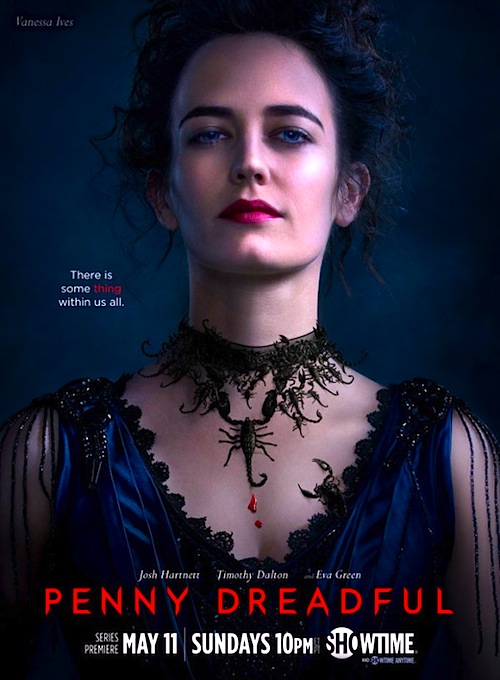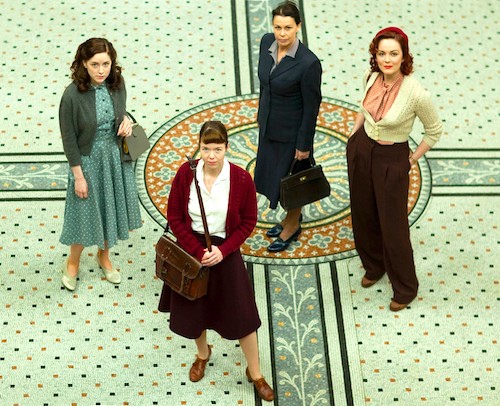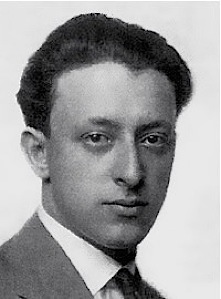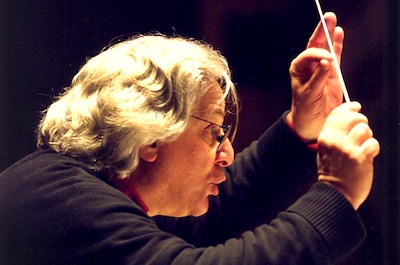By Joe Bendel. George Sanders played Dorian Gray for MGM, so he never could have guest-starred in one of Universal’s multi-monster meet-ups. Showtime’s newest series hints at what strange cinema that might have been. It also makes you wonder how anyone survived Victorian London, with its vampires, re-animated corpses, and generally unsanitary living conditions. The former will be the most pressing issue in the first two episodes of writer-creator John Logan’s Penny Dreadful, which premieres this Sunday.
When a mysterious woman offers American Wild West performer Ethan Chandler some “night work,” he agrees, because she is played by Eva Green. Unfortunately, it turns out turns out she really needs his sharpshooter skills. Vanessa Ives and Sir Malcolm Murray require some back-up when they venture into a vampire’s lair, in search of his long missing daughter. Frustratingly for them, the search will continue, but at least Murray recruits an intense young anatomist to perform all his vampire autopsy needs: Victor Frankenstein.
Needless to say, what Chandler witnesses is a bit unsettling. It is the sort of thing that requires a lot of binge drinking to process in episode two. Proceeding accordingly, Chandler makes the acquaintance of Brona Croft, an Irish working girl, who will soon count Dorian Gray as a client. Since this is premium cable, Gray and his appetites will clearly be supplying most of the sex and nudity quota each week.
 Representing a quarter of Dreadful’s initial eight episode run, “Night Work” (currently available online) and “Séance” are definitely hooky-grabby and absolutely loaded with macabre atmosphere. Helmed with style by J.A. Bayona (director of The Orphanage), they get a lot of mileage from their classic horror tropes. In a few cases, you basically know what is coming, but jump anyway. However, the second episode is further distinguished by the titular séance, which gives Green an opportunity for a massive William Shatner level freak-out. It is not quite at the level of Isabelle Adjani’s supernatural paroxysms in Possession, but that will probably be never be equaled by anybody.
Representing a quarter of Dreadful’s initial eight episode run, “Night Work” (currently available online) and “Séance” are definitely hooky-grabby and absolutely loaded with macabre atmosphere. Helmed with style by J.A. Bayona (director of The Orphanage), they get a lot of mileage from their classic horror tropes. In a few cases, you basically know what is coming, but jump anyway. However, the second episode is further distinguished by the titular séance, which gives Green an opportunity for a massive William Shatner level freak-out. It is not quite at the level of Isabelle Adjani’s supernatural paroxysms in Possession, but that will probably be never be equaled by anybody.
For the most part, Green does her slinky, smarter-than-thou thing and it works like a charm. Timothy Dalton, the criminally underappreciated Bond (after all, Pierce Brosnan succeeded him and we know how that worked out), is appropriately steely as Murray, with a spot of mature dash. While not exactly a naturally strong screen presence, Henry Treadaway’s Frankenstein compensates with plenty of twitchy scenery chewing. Frankly, Josh Harnett broods rather effectively as Chandler, but the jury is still out regarding just what Reeve Carney’s Gray brings to the party. Conversely, even though we hardly meet him in the first two installments, Danny Sapani is clearly poised to become a potential fan favorite as Murray’s imposing majordomo.
It feels like Dreadful will soon be a binge-watching favorite, making good on the unfulfilled promise of the Van Helsing film. With Skyfall’s Sam Mendes on board as executive producer, it has the quality period trappings of BBC historicals, but its heart is closer to late period Hammer films. So far, so good, Penny Dreadful is definitely recommended for vintage horror fans, when it premieres tomorrow (5/11) on Showtime.
LFM GRADE: B+
Posted on May 10th, 2014 at 11:09am.



